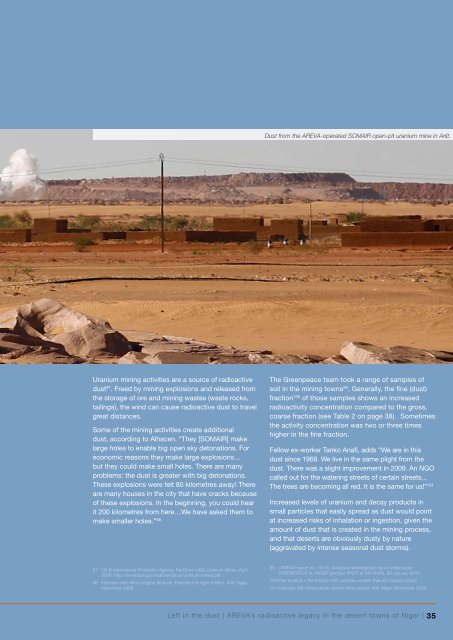Left in the dust - Greenpeace
Left in the dust - Greenpeace
Left in the dust - Greenpeace
You also want an ePaper? Increase the reach of your titles
YUMPU automatically turns print PDFs into web optimized ePapers that Google loves.
Dust from <strong>the</strong> AREVA-operated SOMAIR open-pit uranium m<strong>in</strong>e <strong>in</strong> Arlit.<br />
Uranium m<strong>in</strong><strong>in</strong>g activities are a source of radioactive<br />
<strong>dust</strong> 97 . Freed by m<strong>in</strong><strong>in</strong>g explosions and released from<br />
<strong>the</strong> storage of ore and m<strong>in</strong><strong>in</strong>g wastes (waste rocks,<br />
tail<strong>in</strong>gs), <strong>the</strong> w<strong>in</strong>d can cause radioactive <strong>dust</strong> to travel<br />
great distances.<br />
Some of <strong>the</strong> m<strong>in</strong><strong>in</strong>g activities create additional<br />
<strong>dust</strong>, accord<strong>in</strong>g to Alhacen. “They [SOMAIR] make<br />
large holes to enable big open sky detonations. For<br />
economic reasons <strong>the</strong>y make large explosions…<br />
but <strong>the</strong>y could make small holes. There are many<br />
problems: <strong>the</strong> <strong>dust</strong> is greater with big detonations.<br />
These explosions were felt 80 kilometres away! There<br />
are many houses <strong>in</strong> <strong>the</strong> city that have cracks because<br />
of <strong>the</strong>se explosions. In <strong>the</strong> beg<strong>in</strong>n<strong>in</strong>g, you could hear<br />
it 200 kilometres from here…We have asked <strong>the</strong>m to<br />
make smaller holes.” 98<br />
The <strong>Greenpeace</strong> team took a range of samples of<br />
soil <strong>in</strong> <strong>the</strong> m<strong>in</strong><strong>in</strong>g towns 99 . Generally, <strong>the</strong> f<strong>in</strong>e (<strong>dust</strong>)<br />
fraction 100 of those samples shows an <strong>in</strong>creased<br />
radioactivity concentration compared to <strong>the</strong> gross,<br />
coarse fraction (see Table 2 on page 38). Sometimes<br />
<strong>the</strong> activity concentration was two or three times<br />
higher <strong>in</strong> <strong>the</strong> f<strong>in</strong>e fraction.<br />
Fellow ex-worker Tanko Anafi, adds “We are <strong>in</strong> this<br />
<strong>dust</strong> s<strong>in</strong>ce 1968. We live <strong>in</strong> <strong>the</strong> same plight from <strong>the</strong><br />
<strong>dust</strong>. There was a slight improvement <strong>in</strong> 2009. An NGO<br />
called out for <strong>the</strong> water<strong>in</strong>g streets of certa<strong>in</strong> streets...<br />
The trees are becom<strong>in</strong>g all red. It is <strong>the</strong> same for us!” 101<br />
Increased levels of uranium and decay products <strong>in</strong><br />
small particles that easily spread as <strong>dust</strong> would po<strong>in</strong>t<br />
at <strong>in</strong>creased risks of <strong>in</strong>halation or <strong>in</strong>gestion, given <strong>the</strong><br />
amount of <strong>dust</strong> that is created <strong>in</strong> <strong>the</strong> m<strong>in</strong><strong>in</strong>g process,<br />
and that deserts are obviously <strong>dust</strong>y by nature<br />
(aggravated by <strong>in</strong>tense seasonal <strong>dust</strong> storms).<br />
97 US Environmental Protection Agency, RadTown USA; Uranium M<strong>in</strong>es, April<br />
2006. http://www.epa.gov/radtown/docs/uranium-m<strong>in</strong>es.pdf<br />
98 Interview with Almoustapha Alhacen, President of Aghir <strong>in</strong>’Man, Arlit, Niger,<br />
November 2009<br />
99 CRIIRAD report no. 10-05, Analyses radiologiques de sol prélevé par<br />
GREENPEACE au NIGER (secteur ARLIT et AKOKAN), 28 January 2010<br />
100 F<strong>in</strong>e fraction = <strong>the</strong> fraction with particles smaller than 63 microns (<strong>dust</strong>)<br />
101 Interview with Tanko Anafi, former m<strong>in</strong>e worker, Arlit, Niger, November 2009<br />
<strong>Left</strong> <strong>in</strong> <strong>the</strong> <strong>dust</strong> | AREVA’s radioactive legacy <strong>in</strong> <strong>the</strong> desert towns of Niger | 35

















